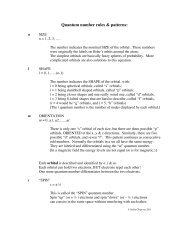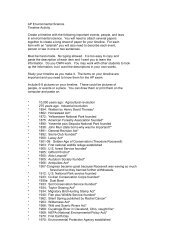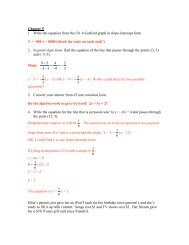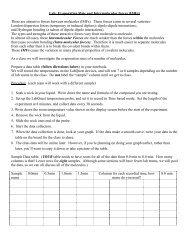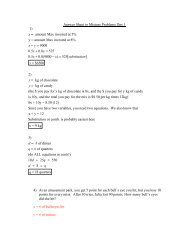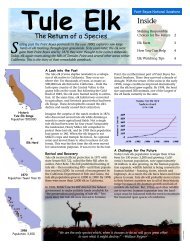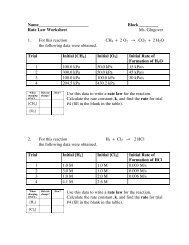AP ENVIRONMENTAL SCIENCE SYLLABUS, 2011 ... - Head-Royce
AP ENVIRONMENTAL SCIENCE SYLLABUS, 2011 ... - Head-Royce
AP ENVIRONMENTAL SCIENCE SYLLABUS, 2011 ... - Head-Royce
- No tags were found...
Create successful ePaper yourself
Turn your PDF publications into a flip-book with our unique Google optimized e-Paper software.
<strong>AP</strong> <strong>ENVIRONMENTAL</strong> <strong>SCIENCE</strong> <strong>SYLLABUS</strong>, <strong>2011</strong>-12MR. VANN, ROOM 410, E-BLOCKWelcome to <strong>AP</strong> Environmental Science (<strong>AP</strong>-ES)! My goals for this course arethe following:1) Make it engaging and interesting2) Make it locally relevant3) Prepare you adequately for the <strong>AP</strong> Exam (Mon, May 7 th , 8am – 1 st one!)To address 1), I have planned several labs, case studies, simulations, and fieldtrips, which I think you will find fun and helpful in understanding the material. Toaddress 2), I have a number of half-day and full-day field trips planned (Tilden BotanicalGardens, Sausal Creek, the HRS Garden, Hawk Hill in Sausalito, and Surfer’s Beach inPescadero) and will tie in locally relevant issues (Coho salmon, the Hayward fault, theOakland fires, and the general plan of Oakland). To address 3), I have selected MultipleChoice Questions (MCQs) and Free Response Questions (FRQs) from past <strong>AP</strong>-ES examsfor us to practice in class, and to assess your understanding of material on tests. While Iwill provide you with as many MCQs as I can in class, I strongly encourage you topractice outside of class as well with any of the following resources:Sample MCQs PDF (a College Board Publication) – 17 questions (free)Study by <strong>AP</strong>P – <strong>AP</strong> Environmental Science – 500 questions ($4.99)Any <strong>AP</strong>-ES practice exam by Barron’s, Princeton Review, etc ($?)If you can get into the habit of doing 10 MCQs per week outside of class, it should go along way to helping you get ready for the exam in May.One main characteristic that distinguishes the content of this course from that ofother <strong>AP</strong> science courses is that <strong>AP</strong>-ES integrates material from a wide range ofdisciplines. Many of these disciplines you would probably expect to see represented inthis course (such as physics, chemistry, biology, and math) but some of the others youmight not (such as ethics, economics, history, and policy).Another important difference from the other <strong>AP</strong> science courses is that <strong>AP</strong>-ES isequivalent to a one-semester college course, not two (which <strong>AP</strong> Bio, Chem, and Physicsare). If you took <strong>AP</strong> Biology last year, you will likely find the pace to be somewhatslower, but fast enough to keep you interested. If you took non-<strong>AP</strong> Biology last year,you will find the pace to be a little faster. FRQs will be new to you, but with a littlepractice, you will quickly become comfortable with them.Please remember that the first test is on Tuesday, September 6 th , which is the firstday back after fall-out. It will include 50 multiple-choice questions, and will be worthhalf the value of future tests.Included in the rest of this syllabus is 1) the sequence of units that we will becovering and any featured labs, field trips, guest speakers, or articles, 2) how the gradingis broken down per semester, and 3) classroom policies.
GRADINGSemester 1 Semester 2• 30% Labs• 40% Labs• 5% Essays• 5% Essays• 5% HW quizzes• 5% HW quizzes• 40% Tests• 50% Tests• 20% Semester Exam<strong>AP</strong> Exam – Monday, May 7th, 2012, 8 a.m.POLICIESBehavior• My expectation is that all students will be respectful to their peers, teacher, guestspeakers, and field trip guides. Students who are not will be dealt with appropriately.Safety• The contract that you signed outlines the safety expectations for the course.Tardiness• Class begins when class begins. Get to know the new schedule. If you are late toclass three times, you will receive a detention.Test Policies• Tests must be taken on the day of the test AND during your assigned period. If youhave an athletic event or family vacation, make arrangements to take the test earlier inthe day, or the day before.• Tests will be curved 10 points above the raw average, but no higher than an 83.5%. Ifthe raw average is above an 83.5%, there will be no curve.• If you miss it due to an absence (excused or not) you will need to take the quartermake-up (given before interims and finals).• If you score below a 70% on a test after the curve, you can take the quarter make-upto raise the grade on that test. The average between the two scores will be recordedas your new grade, but cannot be higher than a 70%.• If you make corrections on the multiple-choice questions before the next test (whichalso entails explaining why the correct answer is correct), you can get a small amountof credit on the tests for doing so. Remember that the value of doing this is for theunderstanding you gain from going over your mistakes.Late Work Policies (for activities and labs)• Work needs to be handed in on the day that it is due, as well as during your classperiod. If it is handed in later without an excuse, it will not be assessed, and you willreceive a 0% for the assignment.• Athletic events and family vacations are not excused absences. Make sure you handin the work before your leave for your event.• If you expect to miss a lab because of an athletic event or a family vacation, arrangeto pick up any work that you will miss in your absence.HW Policies• HW quizzes – one to two per week.• The two lowest HW quiz grades are dropped at the end of the semester.Textbook Policy• Textbooks must have book covers put on them.• If the book is not returned at the end of the year, you will need to pay for the entirecost of the book (instead of 40% of the total cost).
THOUGHTS ON LEVELS OF UNDERSTANDING AND STUDYINGIn the late 1950’s, there was an education psychologist named Benjamin Bloomwho developed a classification system for different levels of understanding. While it is abit dated, I think an understanding of it might lend some insight into how you study.One can think of these levels of understanding like levels in a pyramid in whichone level of understanding supports the next. Each level of understanding can bedemonstrated by certain abilities: the knowledge level by a one’s ability to recallinformation (such as with naming the part of a cell), the comprehension level by one’sability to explain (such as explaining why cells are small), the application level by one’sability to apply an understanding of something to a new situation (such as using anunderstanding of light dependent reactions in photosynthesis to support results in a lab),the analysis level by one’s ability to explain differences between two groups (such aswhy one’s experimental group is different from one’s control group), the synthesis levelby one’s ability to create something (such as designing an experiment), and theevaluation level by one’s ability to assess something (such as looking for sources of errorin an experiment and explaining why they might have lead to the results that occurred).(Phew!)Bloom’s TaxonomyWhen I write questions for tests (or select them from a test bank), I do my best toavoid favoring any one level of understanding. Likewise, when you study, try to keepthis framework in mind as well. Flashcards might help with the knowledge level, butprobably not with the comprehension level. Some levels of understanding may requirethat you think about possible questions that I might ask where you have to apply yourunderstanding of a topic to something (like a set of data). For more on Bloom’staxonomy, you can check out this site:http://www.odu.edu/educ/roverbau/Bloom/blooms_taxonomy.htmNow, can you tell me what level (or levels) of understanding I have demonstratedin relating this to your studying?



